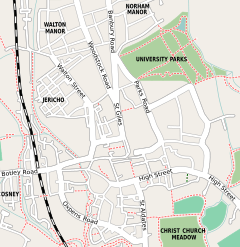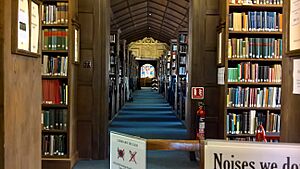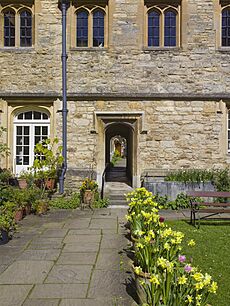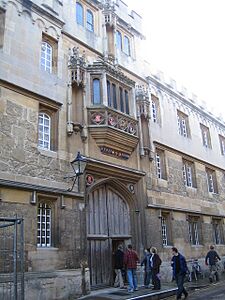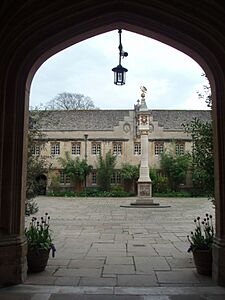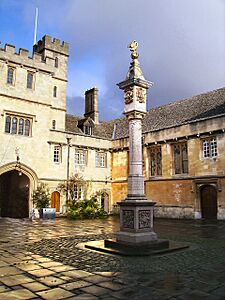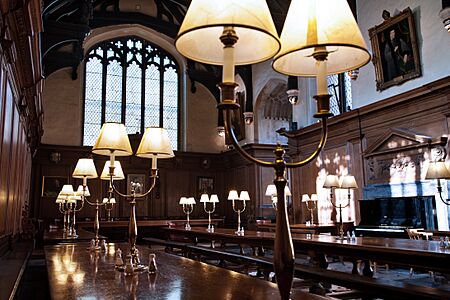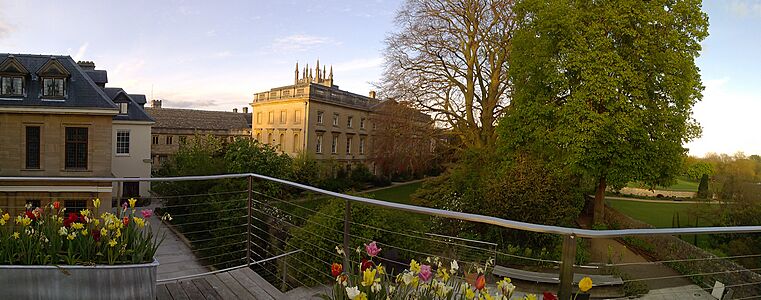Corpus Christi College, Oxford facts for kids
Quick facts for kids Corpus Christi College |
||||||
|---|---|---|---|---|---|---|
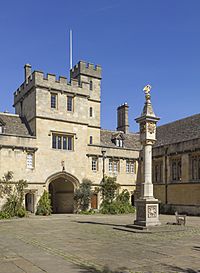 |
||||||
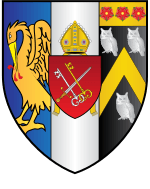
Blazon: see below
|
||||||
|
|
||||||
| University | Oxford | |||||
| Location | Merton Street, Oxford OX1 4JF | |||||
| Coordinates | 51°45′03″N 1°15′13″W / 51.750909°N 1.253702°W | |||||
| Full name | The College of the Body of Christ in the University of Oxford | |||||
| Established | 1517 | |||||
| Named for | Corpus Christi, Body of Christ | |||||
| Sister college | Corpus Christi College, Cambridge | |||||
| President | Helen Moore | |||||
| Undergraduates | 252 (December 2017) | |||||
| Postgraduates | 93 (December 2017) | |||||
| JCR | Corpus Christi JCR | |||||
| MCR | Corpus Christi MCR | |||||
| Boat club | Corpus Christi College Boat Club | |||||
| Map | ||||||
Corpus Christi College (often called Corpus or CCC) is one of the colleges that make up the University of Oxford in the United Kingdom. It was started in 1517, making it the 12th oldest college in Oxford.
The college is on Merton Street, between Merton College and Christ Church. It is one of the smaller colleges at Oxford, with about 250 undergraduate students and 90 graduate students. Corpus is known for its strong academics. It often ranks in the top half of the university's informal ranking system. In 2009–10, it even came in second place!
Corpus Christi College played an important role in translating the King James Bible. The college is also famous for its unique sundial. This sundial is a tall pillar in the main quadrangle, called the Pelican Sundial. It was put up in 1581. In recent years, Corpus also became well-known for winning the TV quiz show University Challenge in 2005. They won again in 2009, but that win was later cancelled.
Contents
History of Corpus Christi College
How the College Started
Corpus Christi College was founded by Richard Foxe, who was a Bishop of Winchester. He was also a very skilled statesman. Foxe worked as a diplomat for King Henry VII. He became a close friend of the King. Later, he was made Bishop of Winchester.
Foxe was also involved with Oxford and Cambridge Universities. He helped found St John's College, Cambridge. He started building Corpus Christi College in 1513. He bought land and buildings, and construction was likely finished by 1520.
Foxe got help from his friend Hugh Oldham, who was the Bishop of Exeter. Oldham gave £4,000 and land to help start the college. Because of his help, he was called the "principal benefactor." A scholarship was even set up for students from Lancashire, where Oldham was born.
King Henry VIII officially approved the college in 1516. The college was formally founded in 1517. Foxe decided that the college would have 20 fellows (teachers), 20 students, three lecturers, two priests, two clerks, and two choristers.
The college's library was very impressive. When it was finished, it was probably the largest and best library in Europe. A famous scholar named Erasmus wrote in 1519 that it was "among the chief beauties of Britain." He also called it a "trilingual library" because it had books in Latin, Greek, and Hebrew.
Later Years and Famous People
In its first 100 years, Corpus Christi College was home to important religious thinkers. These thinkers helped shape the Anglican Christian identity. John Jewel, a Latin teacher at Corpus, helped defend the Protestant ideas of the Church of England. John Rainolds, who became president in 1598, first suggested the idea of the King James Bible. He also helped write it.
Juan Luis Vives, a Spanish scholar, taught at Corpus in the 1520s. He was a tutor to Mary Tudor, who later became Queen Mary I. John Keble, a leader of the Oxford Movement, was a student at Corpus in the early 1800s. Another college, Keble College, Oxford, is named after him.
Corpus Christi College was originally only for men. In 1979, it became one of the many Oxford colleges to welcome its first female undergraduate students. Women graduate students had been admitted five years earlier.
Buildings and Gardens
College Buildings
The main buildings at Corpus Christi College are the Main Quad, the West Building, the MBI Al Jaber Auditorium, the Fellows' Building, Gentleman-Commoners' Quad, and Thomas Quad.
The Main Quad was built when the college was founded. It was designed in a late Mediaeval style. Famous builders who worked for King Henry VIII helped construct it. The architecture of this quad later inspired Oglethorpe University in America.
The chapel is next to the library, just off the Main Quad. Its location is a bit unusual. Many colleges have their chapel right in their main quad. The chapel's lectern (a stand for holding books) is one of the first bronze eagle lecterns in Oxford. It is the only one from before the Reformation.
Other buildings on the main site include the Fellows' Building (built 1706–1716) and the Emily Thomas Building (built in 1928).
Corpus also owns buildings away from the main site. These include the Liddell Building and the Lampl Building. The Lampl Building was finished in 2014.
The Pelican Sundial
The Pelican Sundial is a large pillar in the middle of Corpus' main quad. It was built in 1579. The sundial is named after the gold-painted Pelican on top of the pillar. It's called a "sundial," but it actually has 27 separate sundials on it!
You can easily find nine of them. Four are on each side of the square base below the pelican. Four are under each coat of arms. One faces south on the curved pillar. The other sundials are hidden in hollows and curves. The symbols around the sundials help tell the dates of holidays and the signs of the Zodiac.
The pillar also has three tables. One helps calculate dates for holidays and university terms. Another is a calendar that works for any year. The third helps find the time by moonlight.
History of the Sundial
The Pelican Sundial was designed by Charles Turnball. He lived at Corpus for eight years. He later wrote a book about using a celestial globe.
This wasn't the first sundial at Corpus. An earlier one was designed by Nicholas Kratzer, an astrologer for King Henry VIII. That sundial stood in the garden until about 1706.
The Pelican Sundial has needed a lot of care over the years. Its markings have been replaced many times. Errors also crept into the tables. The sundial even started to lean! This was fixed in 1967 when workers found it had no solid foundation. In 1976, the sundial was restored again. It was most recently restored in 2016.
There are two copies of the Pelican Sundial in America. One is the Mather Sundial at Princeton University. The other is at Pomfret School in Connecticut.
College Gardens
The gardens at Corpus Christi College are very old. Their design has changed a lot over time. In the past, they were very strict and geometric. Now, they are more natural and informal.
Today, the gardens are known for being unique and lively. They are called "wild gardens." The goal is to mix wild and cultivated flowers to create a beautiful and natural landscape. Even small areas, like the "small garden" linking the front quad to the main garden, are carefully designed.
The main garden has the beautiful Fellows' Building on one side. This building is surrounded by colorful shrubs and flowers. Across the lawn, there's a hill with a large copper beech tree. From here, you can see Christ Church Meadow and the gardens of other colleges. It's a lovely view!
The gardening style at Corpus is less formal than at most other colleges. It fits the college's atmosphere. For example, the library windows are framed by bamboo plants. The college also keeps bees, which reminds people of the founder's wish for the college to be a busy place.
The gardeners avoid using weed killers and fertilizers. Even the main lawn is allowed to have wildflowers growing in it. This helps local wildlife. For example, red valerian flowers provide food for caterpillars.
The gardens also have some unusual plants from other parts of the world. These include the trumpet vine, dragon lily, and Brazilian giant-rhubarb. There's even a Wollemi pine, a tree rediscovered in Australia in 1994.
The college has a greenhouse designed by Rick Mather. It looks like a display case. Inside, you can find plants and other interesting items.
College Symbols
The college's coat of arms is quite complex. It combines three different coats of arms:
- The first part shows a pelican feeding its young with its own blood. This was the symbol of the founder, Bishop Richard Foxe.
- The second part shows the symbols of the Diocese of Winchester, which include two keys and a sword.
- The third part shows three owls and roses. These were the symbols of Hugh Oldham, who helped found the college.
The pelican feeding its young is a Christian symbol. It represents Christ nourishing the Church. The college's name, Corpus Christi, means "the body of Christ" in Latin. So, the pelican symbol fits the college's name very well.
Because the full coat of arms is so detailed, the college often uses just the pelican symbol. You can see the pelican on the college tie, the college flag, and on top of the Pelican Sundial.
Traditions
Corpus Christi College has some interesting traditions.
Before every formal dinner in the hall, a special prayer is said. This prayer is in Latin and was written in the college's founding rules. It thanks God for the food and asks for spiritual nourishment.
The college also traditionally keeps at least one tortoise as a living mascot. An elected "Tortoise Keeper" takes care of it. Every year, the college holds a "Tortoise Fair." At this event, the Corpus tortoise races against tortoises from other colleges and local homes. This fun event helps raise money for charity. As of 2013, the college tortoise was named 'Foxe', after the college's founder.
Famous People from Corpus Christi College
Many famous people have studied or taught at Corpus Christi College. These include:
- Isaiah Berlin, a well-known philosopher.
- Vikram Seth, a famous writer.
- Camilla Long, a newspaper columnist.
- Martin Wolf, a financial expert.
- Ed Miliband, a former leader of the Labour Party in the UK.
- David Miliband, a former Foreign Secretary in the UK.
College Presidents
The current president of Corpus Christi College is Helen Moore. She is an Associate Professor and Tutor in English. She was chosen as president on October 19, 2018, for a two-year term. Her work focuses on literature from the Middle Ages and early modern times. She has been a fellow at Corpus since 1996.
Gallery
See also
 In Spanish: Corpus Christi College (Oxford) para niños
In Spanish: Corpus Christi College (Oxford) para niños


